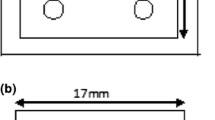Abstract
A new method based on artificial neural networks for calculating the narrow aperture dimension of the pyramidal horn is presented. The Levenberg–Marquardt algorithm is used to train the networks. The narrow aperture dimension calculated using artificial neural networks is used in the optimum gain pyramidal horn design. The computed gains of the designed pyramidal horns are in very good agreement with the desired gains.


Similar content being viewed by others
References
Love AW (1976) Electromagnetic horn antennas. IEEE Press, New York
Balanis CA (1982) Antenna theory: Analysis and design. John Wiley, New York
Hawkins DC (1992) Improvements to synthesis of waveguide horns. Electron Lett 28:879–881
Selvan KT (1999) Accurate design method for optimum gain pyramidal horns. Electron Lett 35:249–250
Guney K (2001) Improved design method for optimum gain pyramidal horns. Int J RF Microwave Computer-Aided Eng 11:188–193
Guney K (2001) Simple design method for optimum gain pyramidal horns. AEU Int J Electron Commun 55:205–208
Guney K (2001) A new design method for optimum gain pyramidal horns. Electromagnetics 21:497–505
Guney K, Hancer H (2003) Improved formulas for narrow and wide aperture dimensions of optimum gain pyramidal horn. Int J RF Microwave Computer-Aided Eng 13:239–245
Haykin S (1994) Neural networks: A comprehensive foundation. Macmillan College, New York
Zhang QJ, Gupta KC (2000) Neural networks for RF and microwave design. Artech House, Boston, MA
Christodoulou CG, Georgiopoulos M (2001) Application of neural networks in electromagnetics. Artech House, MA
Sagiroglu S, Guney K (1997) Calculation of resonant frequency for an equilateral triangular microstrip antenna with the use of artificial neural networks. Microwave Opt Technol Lett 14:89–93
Sagiroglu S, Guney K, Erler M (1998) Resonant frequency calculation for circular microstrip antennas using artificial neural networks. Int J RF Microwave Computer-Aided Eng 8:270–277
Sagiroglu S, Guney K, Erler M (1999) Calculation of bandwidth for electrically thin and thick rectangular microstrip antennas with the use of multilayered perceptrons. Int J RF Microwave Computer-Aided Eng 9:277–286
Karaboga D, Güney K, Sagiroglu S, Erler M (1999) Neural computation of resonant frequency of electrically thin and thick rectangular microstrip antennas. IEE Proc Microwaves, Antennas Propag H 146:155–159
Guney K, Erler M, Sagiroglu S (2000) Artificial neural networks for the resonant resistance calculation of electrically thin and thick rectangular microstrip antennas. Electromagnetics 20:387–400
Guney K, Sagiroglu S, Erler M (2001) Comparison of neural networks for resonant frequency computation of electrically thin and thick rectangular microstrip antennas. J Electromagn Waves Applic 15:1121–1145
Guney K, Sagiroglu S, Erler M (2002) Design of rectangular microstrip antennas with the use of artificial neural networks. Neural Network World 4:361–370
Guney K, Sagiroglu S, Erler M (2002) Generalized neural method to determine resonant frequencies of various microstrip antennas. Int J RF Microwave Computer-Aided Eng 12:131–139
Yildiz C, Gultekin SS, Guney K, Sagiroglu S (2002) Neural models for the resonant frequency of electrically thin and thick circular microstrip antennas and the characteristic parameters of asymmetric coplanar waveguides backed with a conductor. AEU Int J Electron Commun 56:396–406
Guney K, Sarikaya N (2003) Artificial neural networks for calculating the input resistance of circular microstrip antennas. Microwave Opt Technol Lett 37:107–111
Maybell MJ, Simon PS (1993) Pyramidal horn gain calculation with improved accuracy. IEEE Trans Antennas Propagat 41:884–889
Schelkunoff SA (1943) Electromagnetic waves. Van Nostrand Rheinhold, New York
Levenberg K (1944) A method for the solution of certain nonlinear problems in least squares. Q Appl Math 2:164–168
Marquardt DW (1963) An algorithm for least-squares estimation of nonlinear parameters. J Soc Ind Appl Math 11:431–441
Hagan MT, Menhaj M (1994) Training feedforward networks with the Marquardt algorithm. IEEE Trans Neural Networks 5:989–993
Standardization of Electronic Industry Association (EIA) (www.eia.org) and Standardization of International Electrotechnical Commission (IEC) (www.iec.ch)
Author information
Authors and Affiliations
Corresponding author
Rights and permissions
About this article
Cite this article
Guney, K., Sarikaya, N. Artificial neural networks for the narrow aperture dimension calculation of optimum gain pyramidal horns. Electr Eng 86, 157–163 (2004). https://doi.org/10.1007/s00202-003-0197-z
Received:
Accepted:
Published:
Issue Date:
DOI: https://doi.org/10.1007/s00202-003-0197-z




